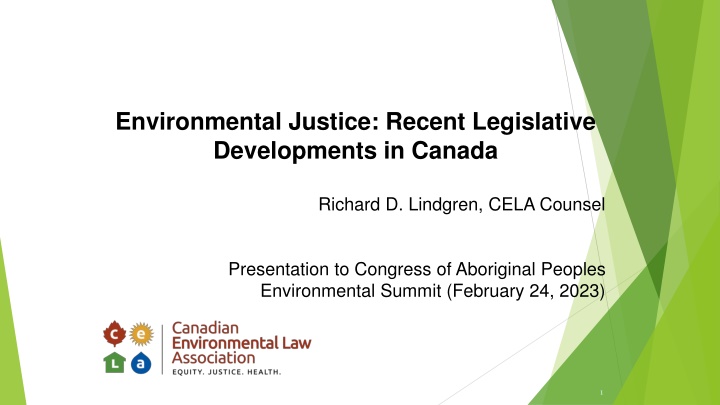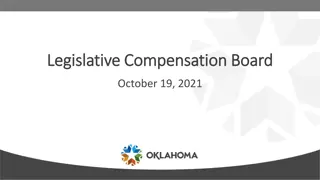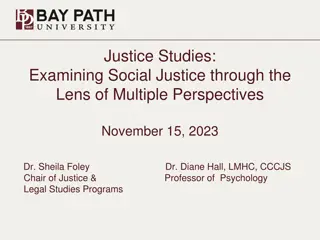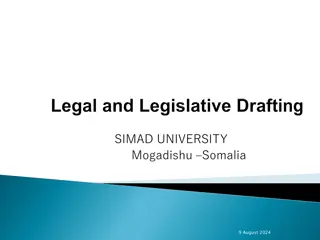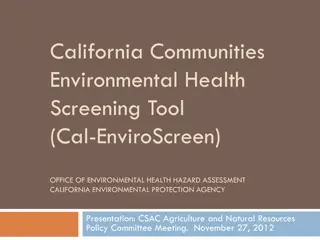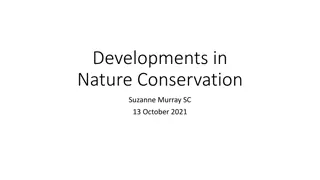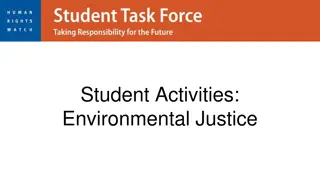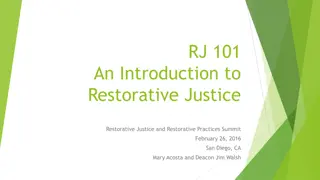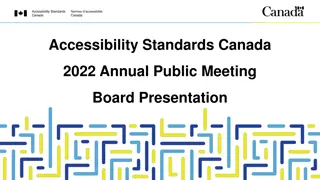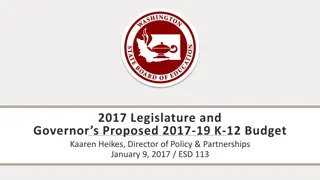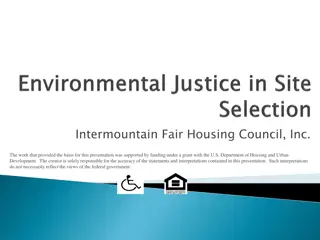Recent Legislative Developments in Environmental Justice in Canada
Presentation by Richard D. Lindgren at the Congress of Aboriginal Peoples Environmental Summit discusses the concept of Environmental Justice (EJ), recent parliamentary initiatives in Canada related to EJ, and the Law Commission of Ontario's project on updating the Environmental Bill of Rights. It also explores the role of CELA in advocating for environmental protection and public health through legal actions. The presentation highlights the disproportionate impact of pollution on certain communities, the importance of fair treatment and meaningful involvement in environmental decision-making, and the global recognition of the right to live in a clean and healthy environment.
Download Presentation

Please find below an Image/Link to download the presentation.
The content on the website is provided AS IS for your information and personal use only. It may not be sold, licensed, or shared on other websites without obtaining consent from the author.If you encounter any issues during the download, it is possible that the publisher has removed the file from their server.
You are allowed to download the files provided on this website for personal or commercial use, subject to the condition that they are used lawfully. All files are the property of their respective owners.
The content on the website is provided AS IS for your information and personal use only. It may not be sold, licensed, or shared on other websites without obtaining consent from the author.
E N D
Presentation Transcript
Environmental Justice: Recent Legislative Developments in Canada Richard D. Lindgren, CELA Counsel Presentation to Congress of Aboriginal Peoples Environmental Summit (February 24, 2023) 1
Overview of Presentation What is Environmental Justice (EJ)? Review of recent Parliamentary initiatives related to EJ (Bill S-5, Bill C-219 & Bill C-226) Review of Law Commission of Ontario (LCO) project on updating & strengthening the Environmental Bill of Rights (EBR)
CELA Background CELA is an Ontario legal aid clinic founded in 1970; our mandate is to use/improve laws to protect the environment/public health & ensure access to EJ CELA represents individuals, groups, and Indigenous communities in the courts & before tribunals
What is EJ? (1) Pollution does not equally affect everyone; it is well-documented that certain communities are disproportionately impacted by siting/permitting decisions that place industrial plants, air/water discharges, or waste facilities in or near such communities This inequity led to EJ activism in the U.S. as part of the civil rights movement in the 1960s; EJ is a high priority for the Biden govt (Justice40 Initiative)
What is EJ? (2) The U.S. EPA definition: Environmental justice is the fair treatment and meaningful involvement of all people regardless of race, color, national origin, or income, with respect to the development, implementation, and enforcement of environmental laws, regulations, and policies. It will be achieved when everyone enjoys: - the same degree of protection from environmental and health hazards, and - equal access to the decision-making process to have a healthy environment in which to live, learn, and work.
EJ in Canada (1) In July 2022, the United Nations General Assembly declared that the ability to live in a clean, healthy and sustainable environment is a universal human right; it also called on countries to scale up efforts to turn that into reality (161 votes for, 0 against, 8 abstentions) Many countries have already entrenched enviro rights in their constitutions, but the Canadian Charter of Rights & Freedoms lacks any explicit reference to enviro quality; however, some enviro cases in Canada have invoked s.7 and/or s.15 of the Charter (e.g., climate change cases)
EJ in Canada (2) Some observers have argued that since a constitutional enviro right is a long-term reform, statutory approaches should be used in the interim Enviro rights can be integrated into existing provincial enviro law (e.g., Quebec s EQA), federal enviro law (e.g., CEPA), or could be enshrined in stand- alone legislation (e.g., EBR)
Proposed Bill S-5 Provisions re EJ (1) Bill S-5 was passed by the Senate in 2022 & is currently undergoing clause-by-clause review by the ENVI Committee in the House of Commons. If enacted, Bill S-5 amends CEPA to: - add a new preamble recital every individual in Canada has a right to a healthy environment as provided under this Act ; - impose a new duty on the federal government to protect the right of every individual in Canada to a healthy environment as provided under this Act, subject to any reasonable limits (s.2(1)(a.2)); and - give federal ministers 2 years to consult upon & develop an implementation framework to set out how the right to a healthy environment will be considered in the administration of this Act (s.5.1(1))
Proposed Bill S-5 Provisions re EJ (2) This framework shall, among other things, elaborate on (a) the principles to be considered in the administration of this Act, such as principles of environmental justice including the avoidance of adverse effects that disproportionately affect vulnerable populations the principle of non-regression and the principle of intergenerational equity; (b) research, studies or monitoring activities to support the protection of the right to a healthy environment referred to in paragraph 2(1) (a.2); (c) the reasonable limits to which that right is subject, resulting from the consideration of relevant factors, including social, health, scientific and economic factors; and (d) mechanisms to support the protection of that right (s.5(2))
Proposed Bill C-219 re EJ(1) This private member s bill received 1st Reading in the House of Commons in December 2021. If passed, this bill would enact the Canadian Environmental Bill of Rights (CEBR): - to safeguard the right of present and future generations of Canadians to a healthy and ecologically balanced environment (s.4(a)); - to confirm the Government of Canada s public trust duty to protect the environment (s.4(b)); - to ensure that all Canadians have access to (i) adequate information regarding the environment; (ii) justice in an environmental context; and (iii) effective mechanisms for participating in environmental decision-making (s.4(c))
Proposed Bill C-219 re EJ(2) This bill defines EJ as a just distribution of environmental benefits and burdens among Canadians, without discrimination on the basis of any ground prohibited by the Canadian Charter of Rights and Freedoms (s.5) If enacted, this bill would create the right to a healthy & ecologically balanced environment (s.6), right to access enviro information (s.7), right to public participation in federal enviro decision-making (s.8), right to access the courts re enviro protection (s.9), & right to request the Auditor General to review federal enviro laws, instruments or policies (s.10); other legal tools also exist in Bill C-219
Proposed Bill C-226 re EJ (1) This private member s bill received 1st and 2nd Reading in the House of Commons in 2022 & was reviewed by the ENVI Committee; the preamble recognizes the need to advance environmental justice across Canada The preamble also notes that a disproportionate number of people who live in environmentally hazardous areas are members of an Indigenous, racialized or other marginalized community and that it is important to meaningfully involve all Canadians and, in particular, marginalized communities in the development of environmental policy and that racial discrimination in the development of environmental policy would constitute environmental racism
Proposed Bill C-226 re EJ (2) if enacted, the bill would give the Enviro Minister 2 years to consult upon, develop, and table a national strategy to promote efforts across Canada to advance environmental justice and to assess, prevent and address environmental racism (s.3 & s.4) This strategy must examine the link between race, socio- economic status and environmental risk and potential measures to address environmental racism (e.g., changes to federal laws; compensation to individuals or communities; collection of information re health outcomes in communities located near enviro hazards) (s.3(3)); the strategy s effectiveness must be reported upon every 5 years (s.5)
LCO Review of Ontarios EBR (1) The EBR was enacted in 1993 & contains various procedural tools that Ontario residents can use to protect the environment (e.g., public notice/comment on govt s enviro proposals, third-party appeal of enviro approvals, Applications for Review or Investigation, civil action to protect public resources, etc.) However, the need to update/strengthen the EBR has been identified by Ontario s Enviro Commissioner, Auditor General, CELA, & other enviro groups The LCO is now preparing a report on EBR reform & enviro accountability; the LCO s discussion paper was released in September 2022
LCO Review of Ontarios EBR (2) The LCO paper poses 16 sets of key questions: - How can EJ be better reflected in the EBR? - Should the EBR entrench the public s right to a healthy environment? - Should the EBR create enforceable rights of nature ? - Should the public trust doctrine be embedded in the EBR? - How should the EBR be modified to meet obligations regarding the rights of Indigenous Peoples? The LCO s final report & recommendations are expected in the spring 2023
References & Resources S-5 (44-1) - LEGISinfo - Parliament of Canada Submissions on Bill S-5, An Act to Amend the Canadian Environmental Protection Act - Canadian Environmental Law Association (cela.ca) C-219 (44-1) - LEGISinfo - Parliament of Canada C-226 (44-1) - LEGISinfo - Parliament of Canada Environmental Accountability: Rights, Responsibilities and Access to Justice LCO-CDO Potential Reforms to the Environmental Bill of Rights - Canadian Environmental Law Association (cela.ca) Environmental Justice | US EPA
